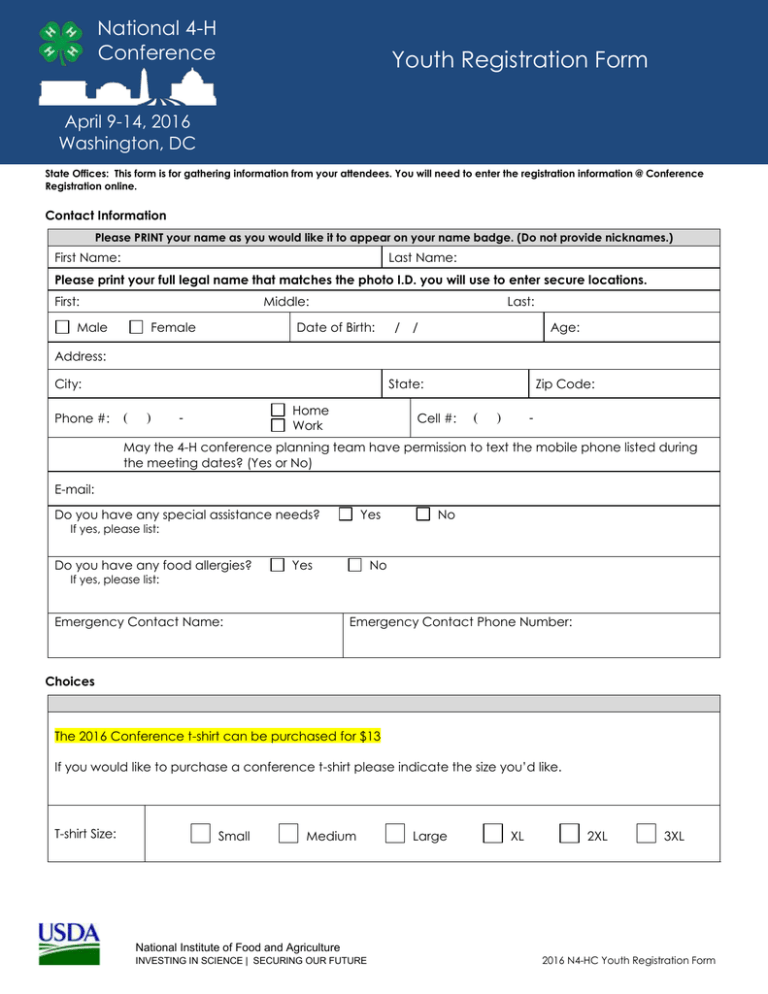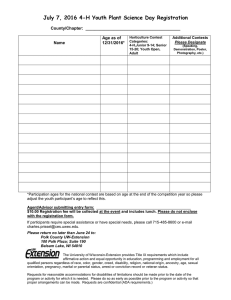2016 Registration Form
advertisement

National 4-H Conference Youth Registration Form April 9-14, 2016 Washington, DC State Offices: This form is for gathering information from your attendees. You will need to enter the registration information @ Conference Registration online. Contact Information Please PRINT your name as you would like it to appear on your name badge. (Do not provide nicknames.) First Name: Last Name: Please print your full legal name that matches the photo I.D. you will use to enter secure locations. First: Middle: Male Last: Date of Birth: Female / / Age: Address: City: Phone #: State: ( ) Home Work - Zip Code: Cell #: ( ) - May the 4-H conference planning team have permission to text the mobile phone listed during the meeting dates? (Yes or No) E-mail: Do you have any special assistance needs? Yes If yes, please list: Do you have any food allergies? Yes No No If yes, please list: Emergency Contact Name: Emergency Contact Phone Number: Choices The 2016 Conference t-shirt can be purchased for $13 If you would like to purchase a conference t-shirt please indicate the size you’d like. T-shirt Size: Small Medium Large XL 2XL 3XL National Institute of Food and Agriculture INVESTING IN SCIENCE | SECURING OUR FUTURE 2016 N4-HC Youth Registration Form National 4-H Conference April 9 -14, 2016 Washington, DC Roundtable Topics Rank the top three(1-3) Roundtable Topic Discussions you would most like to participate in: (Please use the Challenge Question on page 3 to assist with your choices) You will be involved in one Roundtable Discussion. _____ Analyzing Climate – NASA (National Aeronautics and Space Agency) _____ Importance of Agriculture – House/USDA (U.S. House of Representatives Committee on Agriculture / United States Department of Agriculture Administration) _____ Backyard Farming – NIFA (National Institute of Food & Agriculture) _____ Food Networks – EPA (Environmental Protection Agency) _____ Bioenergy – DOE (Department of Energy) _____ Irrigation Options – NRCS (Natural Resources and Conservation Service) _____ Climate Change – NOAA (National Oceanic and Atmospheric Association) _____ Disaster Health Impacts – ASPR (Assistant Secretary for Preparedness & Response at Health & Human Services) _____ Emotional Safety – SAMHSA (Substance Abuse & Mental Health Services Administration) _____ Strengthening Communities – CNCS (Corporation for National and Community Service) _____ Fitness – PCFSN (President’s Council on Fitness, Sport & Nutrition) _____ Plan & Save – DOL (Department of Labor) _____ College Ready – DOE (Department of Education) _____ Business Training – SBA (Small Business Administration) _____ Choosing Peace – State (Department of State) National Institute of Food and Agriculture INVESTING IN SCIENCE | SECURING OUR FUTURE 2016 N4-C Youth Registration Form National 4-H Conference National 4-H Conference – 2016 Roundtable Topics April 9 -14, 2016 Washington, DC General Topic Analyzing Climate Importance of Agriculture Challenge Question Host Develop a set of recommendations to get youth involved in taking observations of rainfall, soil moisture, plants, clouds, and air quality to help NASA understand and monitor climate change and its impact on agriculture across the United States. How can youth be engaged in analyzing observations to answer environmental questions in their local community? What resources and support could NASA provide to help youth become leaders in their communities to communicate the impact of climate change on agriculture and encourage others to submit observations? Exploring the importance of agriculture with the House Ag Committee. NASA (National Aeronautics and Space Agency) Backyard Farming Develop a set of educational tools and resources that could be used with the general public to prepare the backyard farmer to grow products organically. Food Networks How can a network be created to connect edible crops and produce that are not sent to market, to those that are in need of healthy, wholesome food? What are the edible crops/produce being left? Where are the viable donation centers (shelters, food banks, faith organizations etc.)?What is the best mechanism to create that network (an app, community message boards etc.)? Create an infographic that answers one of the following prompts: 1. How would you define sustainable transportation? How can sustainable bioenergy technologies help meet sustainable transportation goals? 2. Compare and contrast the environmental impacts of bioenergy and fossil energy, such as greenhouse gas emissions, water usage, energy balance, soil productivity, biodiversity, etc. Agriculture is a big consumptive user of water, and as such, can be part of the solution to water shortages. An alternative is to use another source of water not traditionally used for irrigation. One non-traditional source of water is the effluent from the Wastewater Treatment Plant. What are the positive aspects about using this treated water to provide irrigation water? What are the negative issues? How is your community being affected by climate change? How can you and other young people help make your community more resilient to climate change? Design a communication product, such as a video, blog, story, social media campaign, or game, to share your experience with your peers and engage them in making their own communities more resilient and sustainable. Identify natural hazards that commonly affect your community and describe the potential impact these hazards have on your community’s health. Develop unique ways that you might facilitate your local community leaders, businesses and/or organizations to work effectively together to prevent or minimize these health impacts and strengthen your community’s ability to prepare. How can 4-H implement a trauma-informed approach to engage and empower youth and help them share their adverse life experiences to leverage positive change in the community? Bioenergy Irrigation Options Climate Change Disaster Health Impacts Emotional Safety Strengthening Communities Fitness Plan & Save AmeriCorps programs connect people to service opportunities through organizations across the country focused on strengthening communities and improving lives. We want to make AmeriCorps.gov more appealing and easier for people to learn how to join AmeriCorps programs. How can we use AmeriCorps.gov to better explain how AmeriCorps members help lift people out of poverty? What is the state of inclusion for youth with disability in school/community health and fitness programs? What role can youth without disabilities play to make sure youth with disabilities will be included in health and fitness programs or opportunities in their school or community? Consider how to encourage young adults, ages 16 to 24, who come from low-income rural and urban backgrounds (may even be new parents themselves) and are earning their first paychecks to learn about financial literacy and save and plan for their future financial needs. How do we reach this audience? What messages will motivate them to plan and save? College Ready What do teens need to be ready – socially and emotionally – to move away from home and go off to college? Design resources that teens and their families can use to help them through this transition process. Business Training As SBA continues to update its digital tools and resources for millennial entrepreneurs, we would like the student’s feedback on our millennial webpage and our young entrepreneurs’ e-learning course. Feedback should include any ideas the students may have for updating current webpages and courses and creating new content. If you were to serve as adviser to the U.S. Secretary of State, what strategies would you recommend that the Department of State consider implementing to help ensure that youth in America and abroad become and stay engaged in peaceful, positive activities and organizations, rather than be enticed to join and participate in groups or organizations that may have violent or extremist intentions or actions? What experiences or activities in which you are engaged would work internationally? Choosing Peace House/USDA (U.S. House of Representatives Committee on Agriculture / United States Department of Agriculture Administration) NIFA (National Institute of Food & Agriculture) EPA (Environmental Protection Agency) DOE (Dept. of Energy) NRCS (Natural Resources & Conservation Service) NOAA (National Oceanic & Atmospheric Association) ASPR (Assistant Secretary for Preparedness & Response at Health & Human Services) SAMHSA (Substance Abuse & Mental Health Services Administration) CNCS (Corporation for National and Community Service) PCFSN (President’s Council on Fitness, Sport & Nutrition) DOL (Department of Labor) ED (Department of Education) SBA (Small Business Association) State (Department of State) National Institute of Food and Agriculture INVESTING IN SCIENCE | SECURING OUR FUTURE 2016 N4-C Youth Registration Form
